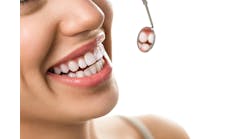Michael Miller, DDS
I have repaired porcelain several times in the past with reasonably good success. However, I am having a problem with one particular case. It involves a roundhouse bridge. The porcelain on a lateral incisor (#7) broke with an exposure of metal. I used the technique described in REALITY and unfortunately it only lasted overnight. I then microetched the metal and HF-etched the porcelain. I then coated the porcelain with silane and proceeded to bond a composite repair. This time, it lasted about a week. I suspect the "bond" to the metal as the weak link. Any suggestions? My lab suggested making an overlaying crown once all porcelain is removed from the crown. Appreciate any help. Thanks.
Our latest information shows that using Alloy Primer from Kuraray will enhance bond strength to metal. Do these steps:
(1) Mask uninvolved areas with LC Block-Out (Ultradent).
(2) Sandblast entire area to be repaired.
(3) Rinse and dry well.
(4) Etch porcelain (not metal) with 9.5percent HF for two minutes.
(5) Rinse and dry well. Remove LC Block-Out.
(6) Apply Alloy Primer to the sand-blasted metal and dry gently with air.
(7) Apply silane to the porcelain and dry gently with air.
(8) Apply unfilled resin such as Helio-bond, brush off excess, and light- cure for 20 seconds.
(9) Apply repair material.
(10) Tell patient not to stress the repair for 24 hours. Be sure to adjust occlu- sion to relieve repaired area from heavy contact.
If that doesn`t work, you may try all the above steps after creating some undercuts in the metal with a highspeed bur.
I have used Demetron curing lights since their inception and have been very pleased with their quality. I am now evaluating the Optilux 501. I am concerned about Kerr`s claims that it is as effective for high-speed curing as a laser. The turbo tip will register 1100 mW/cm2, but it creates a lot of heat. The four different functions are interesting, but is it just a marketing ploy? I have heard that it has the same bulb as the older Demetrons. If so, how can they produce greater energy?
Our full report on the Optilux 501 is in the 2000 annual edition of REALITY. In summary, it appears the power of the bulb, which is the same 80 watts as in the Optilux 500 and 401, has been maximized to produce more energy at the end of the Turbo tip. Our preliminary tests have not found a significant difference in leakage between the various curing modes, but additional testing is ongoing. The Optilux 501 is our only five-star curing light and gives you all the polymerization options. These options could prove to be very valuable when the research has caught up to the product development.
Many of the comments in REALITY have discouraged the use of some self-curing core materials and bonding agents due to lack of bond. CoreRestore is packaged with OptiBond Solo. According to REALITY, these two products do not work together. Kerr claims it is not a problem. I would like comments on what type of adhesive should be used with self-cure or dual-cure core materials and the appropriate bonding agents.
Our tests indicate CoreRestore does not bond to OptiBond Solo. Therefore, we do not recommend using them together. When placing a dual-cure or self-cure core material, the safest bet is a dual-cure adhesive such as Prime & Bond NT Dual Cure or Cabrio Dual Cure. One-Step from Bisco is the only single-component adhesive that we have found to be compatible with self-cure composites.
I would like to find an impression material that is a substitute to alginate for diagnostic and bleaching impressions. Preferably, it would be a material that could be poured more than once, with minimal bubbles, and hopefully an economical substitute to alginate.
Position Penta by ESPE is your best bet. It is a low-cost vinyl that some clinicians are even successfully using for simple crown-and-bridge impressions. While it does not have the body of alginate, which helps to register deep palatal vaults and vestibules, its ease of mixing and lack of mess make it a desirable alternative.
Dr. Miller is the publisher of REALITY and REALITY Now, the information source for esthetic dentistry. He is an international lecturer and a fellow of the American Academy of Cosmetic Dentistry, as well as a founding member. He maintains a private practice in Houston, Texas. For more information on REALITY and to receive a complimentary issue of his monthly update, REALITY Now, call (800) 544-4999 or visit www.reality=esthetics.com.





